
Aquatic plants are plants that have adapted to living in aquatic environments. They are also referred to as hydrophytes or macrophytes to distinguish them from algae and other microphytes. A macrophyte is a plant that grows in or near water and is either emergent, submergent, or floating. In lakes and rivers macrophytes provide cover for fish, substrate for aquatic invertebrates, produce oxygen, and act as food for some fish and wildlife.

Umbilicus rupestris, the navelwort, penny-pies or wall pennywort, is a fleshy, perennial, edible flowering plant in the stonecrop family Crassulaceae in the genus Umbilicus so named for its umbilicate (navel-like) leaves.
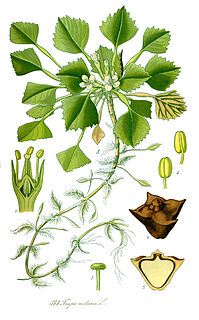
The water caltrop is any of three extant species of the genus Trapa: Trapa natans, Trapa bicornis and the endangered Trapa rossica. It is also known as buffalo nut, bat nut, devil pod, ling nut, lin kok, ling jow, ling kio nut, mustache nut or singhara.

Centella asiatica, commonly known as Gotu kola, kodavan, Indian pennywort and Asiatic pennywort, is a herbaceous, perennial plant in the flowering plant family Apiaceae. It is native to wetlands in the Caucasus, Tropical & Subtropical Old World to New Zealand and the West Pacific. It is used as a culinary vegetable and as a medicinal herb.
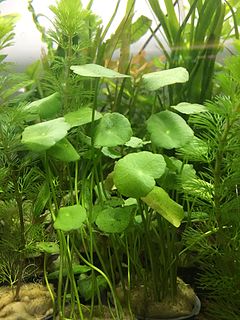
Hydrocotyle umbellata is an aquatic plant that thrives in wet, sandy habitat. Its English common name is manyflower marshpennywort or dollarweed. It is native to North America and parts of South America. In Brazil it is known as acariçoba and has applications in herbal medicine with purported anxiolytic, analgesic and anti-inflammatory properties. It can also be found growing as an introduced species and sometimes a noxious weed on other continents. It is an edible weed that can be used in salads or as a pot herb.

Hydrocotyle, also called floating pennywort, water pennywort, Indian pennywort, dollar weed, marsh penny, thick-leaved pennywort and even white rot is a genus of prostrate, perennial aquatic or semi-aquatic plants formerly classified in the family Apiaceae, now in the family Araliaceae.

Hydrocotyle ranunculoides, known commonly as floating pennywort, or floating marshpennywort, is an aquatic plant in the family Apiaceae. It is native to North and South America.
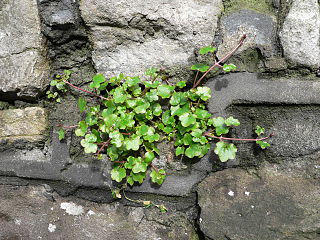
Cymbalaria muralis, with common names ivy-leaved toadflax, Kenilworth ivy, coliseum ivy, Oxford ivy, mother of thousands, pennywort, wandering sailor, is a flowering plant in the family Plantaginaceae native to Mediterranean Europe and widely naturalised elsewhere.

Hydrocotyle verticillata, also known as whorled pennywort, whorled marshpennywort or shield pennywort, is a flowering plant found in South and North America and the West Indies. The creeping plants with unusual leaves give it its common names. It grows in places that are marshy, boggy, and wet.
Hydrocotyle verticillata is used in aquaria, where it is undemanding but prefers a good substrate, and at least moderate light. It benefits from additional carbon dioxide. It is widely used as a foreground plant.

Hydrocotyle vulgaris, the marsh pennywort, common pennywort, water naval, money plant, lucky plant or copper coin, is a small creeping aquatic perennial plant native to North Africa, Europe, the Caucasus and parts of the Levant.
H. vulgaris may refer to:

Nymphaea nouchali, often known by its synonym Nymphaea stellata, or by common names blue lotus, star lotus, red water lily, dwarf aquarium lily, blue water lily, blue star water lily or manel flower, is a water lily of genus Nymphaea. It is native to southern and eastern parts of Asia, and is the national flower of Bangladesh and Sri Lanka. In Sanskrit, it is utpala. This species is usually considered to include the blue Egyptian lotus N. nouchali var. caerulea. In the past, taxonomic confusion has occurred, with the name Nymphaea nouchali incorrectly applied to Nymphaea pubescens.
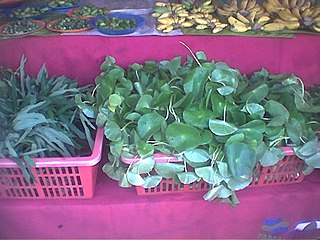
Hydrocotyle javanica, commonly known as Java pennywort, is a species of Hydrocotyle. It is a prostrate herb found in NE India and SE Asia. Leaves are simple, circular-heart-shaped, with seven triangular shallow lobes. Leaves are 2.5-5 x 3–5.5 cm in size, and the margin has rounded teeth. Java pennywort is closely related to Indian pennywort. Tiny white flowers arise in 20 flowered umbels. Java pennywort is seen in shady, moist places at altitudes greater than 1300 m. Flowers have five greenish-white petals and five stamens. Fruit is broadly ovoid, 1 mm, laterally compressed. In Manipur, the leaves are eaten as a substitute for Indian pennywort. Flowering: June–July.
American pondweed is a common name for several aquatic plants, and may refer to:
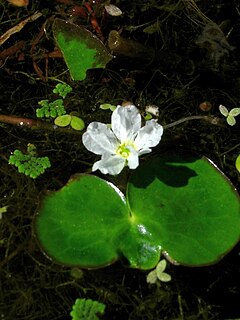
Nymphoides hydrophylla, commonly known as crested floating-heart, is an aquatic plant of the family Menyanthaceae native to tropical Asia. It has cordate floating leaves that support a lax inflorescence of dainty white flowers with fringed petal margins. Its slim stem (spear) is edible, and is used as vegetable in Taiwan, mostly produced at Meinong District, Kaohsiung.
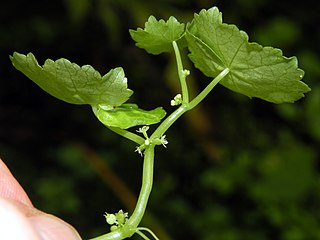
Hydrocotyle americana is a small plant native to the Northeastern United States. It is commonly referred to as American marshpennywort or navelwort and American water-pennywort. H. americana grows from Ontario to Newfoundland south through the Appalachian mountains to South Carolina. H. americana has been introduced to South Africa as well as New Zealand.
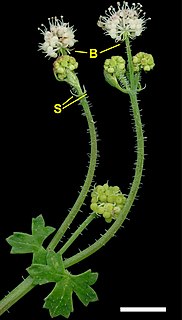
Hydrocotyle phoenix is a species of annual pennywort and is commonly called fire pennywort. It is only known to grow in south-west Australia, specifically in fire prone habitats; it is unique in this regard as it is the only species of Hydrocotyle known to have a fire adapted life-history. The specific epiphet "phoenix" references this fire adapted life history as in Greek mythology, a Phoenix experiences rebirth by rising from ashes, much like how this plant rises from the ashes after a wildfire.
Listronotus elongatus is a weevil native to South America, of the genus of underwater weevils Listronotus. It lays eggs on and eats the invasive floating pennywort. The larvae also eat into the stems, reducing the pennywort's ability to grow. Despite not being native to Britain, it has been introduced into waterways in Britain for biocontrol of the floating pennywort, following extensive research to establish that the weevil is not a threat in itself.















